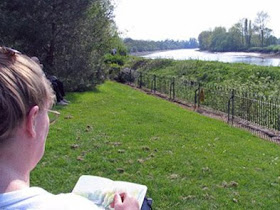This post is about:
- using Google Street View to provide artists with landscape painting opportunities and
- Bill Guffey's pioneering use of it forThe Virtual Paintout project and blog.
I'm pretty much confined to home at present. I have real problems with balance caused by falls caused by a disabling condition in my feet. Walking on wet snow, slush and ice is a very high risk activity for me. In the past I've had falls on completely dry pavements which have almost always led to six weeks on crutches so any conditions which increase the likelihood of falls are avoided as part of my risk management strategy.
However at least I can get out and about and do walk a lot when the weather is better with a view to strengthening the spaghetti junctions in my ankles. (Believe me = breaking a bone is a complete breeze compared to tearing ligaments and tissue in your feet!)
However many people with disabilities greater than mine don't have the mobility I have. Many people can be confined to their homes for long periods and can have significant problems with travelling to see landscapes and paint. However
Google Street View appears to offer some scope for artists to travel in a virtual world and paint in the real world that was never envisaged when this development of Google Maps was created.
Google Street ViewBill Guffey (
Bill Guffey), a Kentucky artist, is the person who has been responsible for uncovering the potential of Google Street View.
First he started experimenting with Google Street View to complete a series of paintings, one from each state in the U.S. You can see his
Street View State Series on his website. In doing this he contacted Google to find out what was and was not possible.
Using Google Street View as a source is legal - He secured the agreement of Google to the effect that it is permissable for artists to use Google Street View as a reference when working in traditional methods to create art.
All Google requires that if you choose to show the original Street View screen shot on which a painting is based on your blog or website, then the Google logo and copyright MUST be visible in the screenshot. There is no requirement for it to be acknowledged in any way in the actual painting.
Bill has also been complimented by by Google for his inspiring use of their technology.
Bill's use of Street View, to inspire his paintings and to create a virtual community of artists, is a remarkable example that we hadn't imagined but are really excited to see.
Stephen Chau, Google Street View product manager
Benefits for artists with disabilities - As Bill highlights on his blog...........
This opens up an entire world for artists that are disabled and confined to their homes or facilities, or with restricted mobility.
I think this aspect is really terrific for artists with disabilities. It's also the reason why I've chosen to highlight it today given that I'm sitting here and staring out the window at the snow coming down in London!
The Virtual Paintout Bill subsequently started
The Virtual Paintout as a blog project.
The Main Rule
The artist must use a view found through Google Street View as the reference for the painting or drawing. Artwork created from photographs not acquired through Google Street View will not be accepted. User Photos found as thumbnails in the upper right hand corner on some views are not acceptable. Thanks.
To date the Virtual Paintout has visited the following places. If you click on the links you can view the paintings produced by participants as a result.
Below you'll find an example of a painting produced for the London project. This painting by
Gary Nemcosky is of Westminster Abbey from Totley Street in London - and below is the nearest I could get to the Google Street View. Gary is an artist and art educator living in the mountains of western North Carolina - a long way from Westminster! This is a link to his blog post about the painting -
Virtual Paintout - London, England and this was his conclusion!
This was a lot of fun to do and I would recommend this kind of activity to anyone
 Westminster Abbey
Westminster Abbey
12x16" watercolor on Kilamanjaro 140 lb. block.
Gary Nemcosky So - have you tried painting from Google Street View or participated in The Virtual Paintout?
- How did you find it? What are the pros and cons?
- Do you have any tips for others having a go?
Links:





















-la-pie-.jpg)